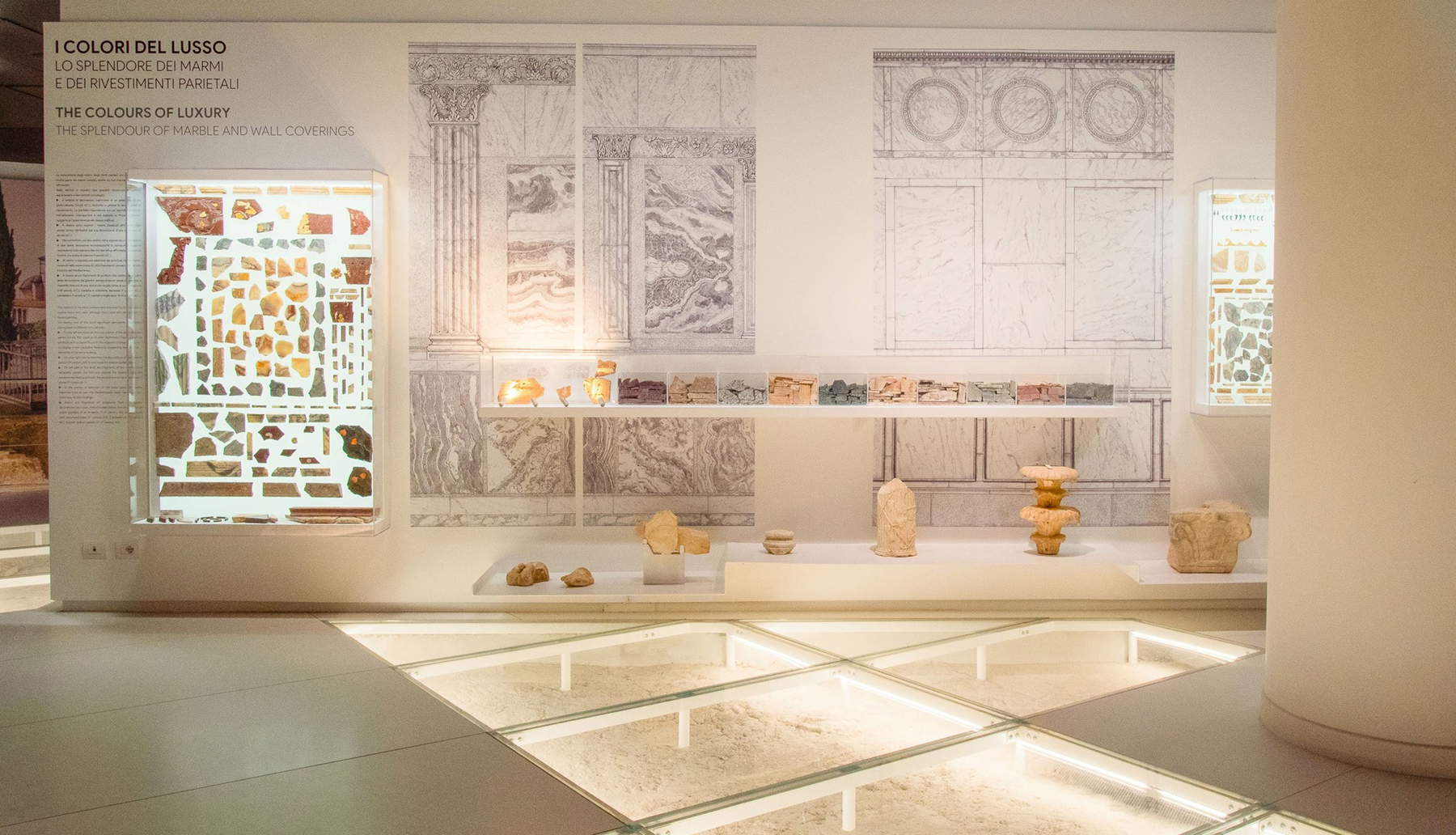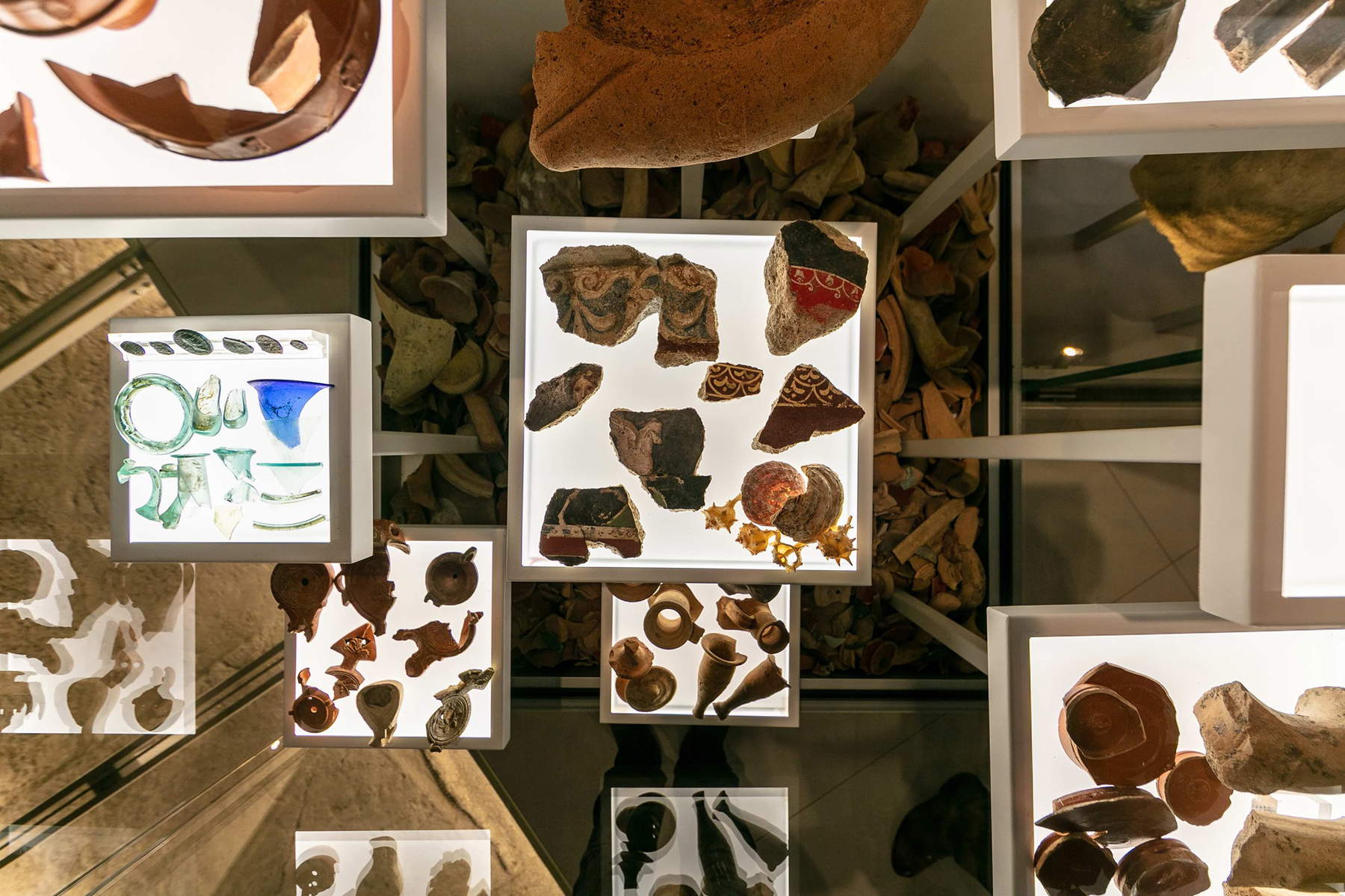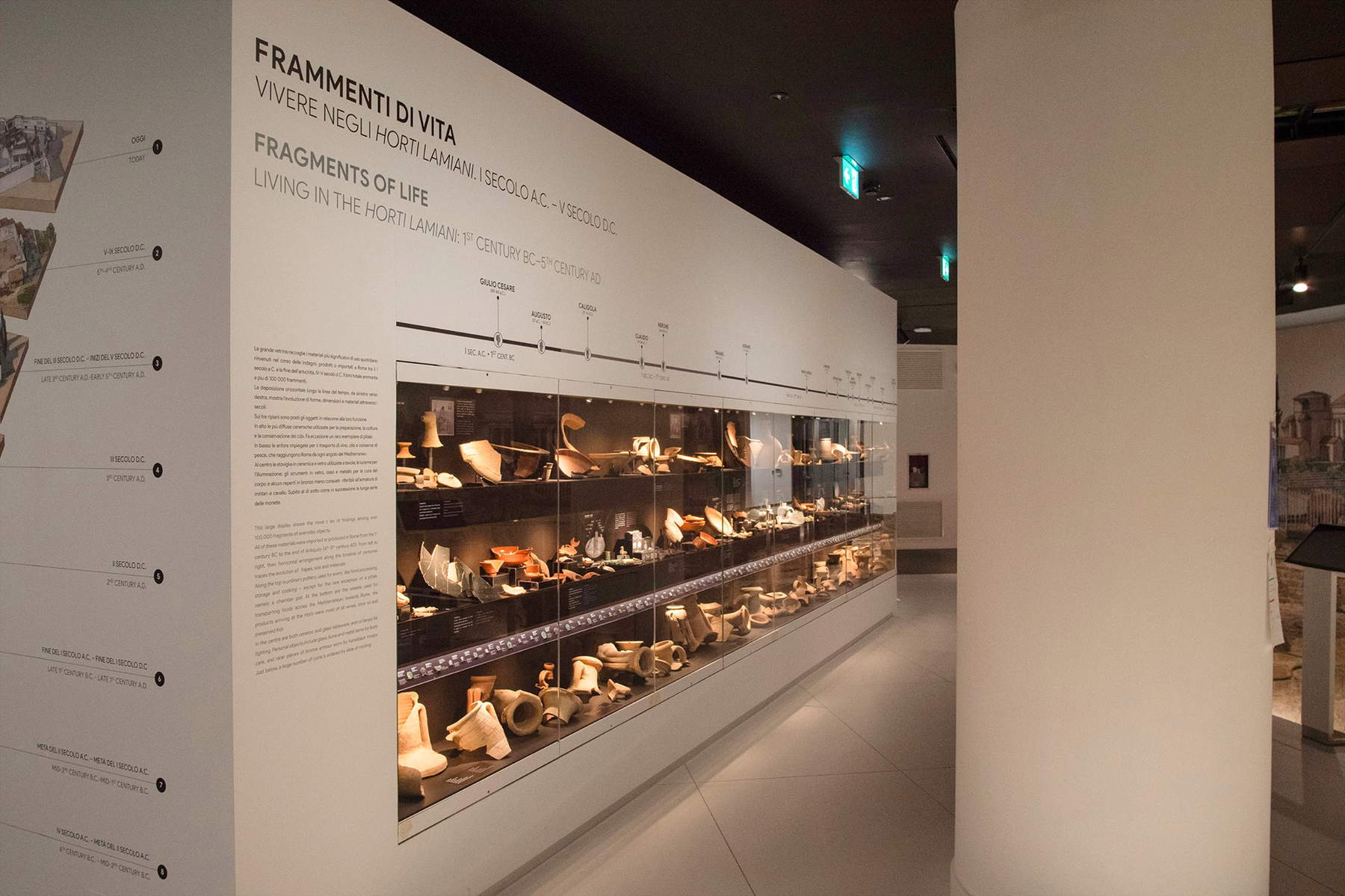A new museum is opening in Rome: it is the Nymphaeum Museum, which will revive the Horti Lamiani, a mythical place in Roman history. The museum, created jointly by the Special Superintendence of Rome and Enpam - Ente Nazionale di Previdenza ed Assistenza dei Medici e degli Odontoiatri (National Board of Welfare and Assistance for Doctors and Dentists), will open with “open days” on Oct. 30 and 31, and will officially open to the public from Nov. 6. The museum was created on the site of the discovery of an exceptional archaeological context, which came to light in the area of Piazza Vittorio allEsquilino, during the work for the construction of the headquarters of the institution.
The museum presents evidence and artifacts since the Julio-Claudian period, when the Horti Lamiani became part of the imperial domain under Tiberius, and by Caligula transformed into a sumptuous private residence for the use of the emperor. A sort of Domus Aurea ante-litteram, also beloved by later Flavian, Antonine, and even Severan emperors to whom we owe the latest transformations of the luxurious rooms. Each epoch left its mark here, and the more than one million artifacts found in the excavations have been selected thanks to the careful study in the secret laboratory carried out in collaboration with researchers specializing in various disciplines. There are three thousand objects on display, flanked by reconstructions and videos, to restore through 13 sections the suggestion of life and different aspects of ancient culture. In addition, along the stairs leading to the archaeological area, an electronic stele commemorates the names of all the doctors who fell fighting against Covid-19.
Located in Vittorio Square, the museum is based on a museum project designed to bring every visitor closer and return the archaeological remains and many artifacts to everyone. Thanks to a two-stage survey (2006 - 2009; 2010 - 2015) on which 12 archaeologists worked, with 30.000 cubic meters of excavated soil and millions of accumulated artifacts, a well-equipped laboratory with a team of 18 specialists who studied the finds for five years, and painstaking recovery work with six restorers, the museum presents itself to the public as a large fresco on ancient Rome and the many people who lived here: from monumental architecture to sumptuous decorations, trade routes, precious objects, and everyday objects, to food and landscape. Each of the carefully researched finds has been selected and is displayed for what it can tell about the ancient city. According to modern archaeological practice, not only architectural structures but also objects and decorations are displayed where they were found, with the intention of evoking a unique, in many ways legendary, context. From the major historical-economic themes, we move on to the urban organization of the Horti Lamiani, the viability and functional spaces of the Esquiline, and on to the real life of imperial Rome and beyond. The project also stems from an important network of collaborations and multidisciplinary research in collaboration with multiple university departments and freelancers. The direction of the project has been entrusted to Mirella Serlorenzi.
The museum will open, from Nov. 6, every Saturday and Sunday from 10 a.m. to 1 p.m. and 3 p.m. to 6 p.m. Visit with audio guide 10 euros, reduced 6 euros, guided tour 13 euros, reduced 8 euros, free for doctors and dentists.


The most important finds date from the imperial ages: Gaius Cilnius Maecenas, in the second half of the first century BC, reclaimed the burial ground, a public space, to transform it into a private space dedicated to the construction of residences for many members of the new aristocracy, the homines novi of the Augustan age, including Lucius Aelius Lamia. An exponent of a family of knights elevated by Augustus to the rank of senator, Lamia built his very luxurious residence, the Horti Lamiani, on the Esquiline, and upon his death in 33 CE, left his property to the imperial domain. These were the last years of the principate of Tiberius, who nevertheless had little interest in life in the capital. Instead, the sources, particularly Philo Alexandrinus, testify how his successor Caligula, who became emperor in 37 CE, was fond of the Horti Lamiani, and ordered an even more luxurious arrangement, thus creating his own Domus aurea ante litteram. Prominent among the precious finds from the time of the Julio-Claudian emperors is a monumental curved marble staircase, and then more frescoes, decorations, and many materials of everyday life. Among them, a water system with the name of Emperor Claudius (Caligula’s successor) stamped on the lead pipes certifies the era of its construction. Particularly striking was the discovery of fragments of window glass: in fact, Philo Alexandrinus writes that Caligula “First rushed into the great hall, went round it, and ordered that the windows all around be restored with transparent material such as white glass... ”(Legatio ad Gaium).
While every emperor since the first century A.D. has wanted to leave his mark on this luxurious residence on the Esquiline, a monumental architectural structure from the Severan period stands out in the excavation: an unroofed hall with walls paved with fine marble and paved with large white marble slabs with a large nymphaeum fountain, which still exists. This is the most architecturally important find for what it can tell about the imperial residence and which ancient sources date back to Alexander Severus. An emulation of public spaces not unlike a forensic area, the nymphaeum plaza was decorated with sculptural groups, herms, flower vases: an evocative place where the princeps could have moments of meditation and solitary idleness, receive important guests, ambassadors, delegations from provinces all over limpero. Monumental architecture, interiors and exteriors decorated with statues, precious marbles, fountains and water features are all elements found in the excavations that testify to the luxury and elegance of the Horti, which imitated Hellenistic and Oriental royal palaces, which in turn were marked by a sacred conception of kingship.
Limpant number of artifacts unearthed during the archaeological investigations formed the basis for a workshop where a careful study was made of the customs, habits, and trade of the Roman empire as seen from the perspective of its capital, Rome. In addition to the marbles, from the most distant provinces, it was the abundant finds of amphorae for food use, also from the most disparate regions, that made it possible to identify the routes of trade through the various eras, both in the Mediterranean basin and in northern Europe. Almost a modern tracing, a map of which is displayed with examples of the types of amphorae and their provenance. More than 100,000 artifacts from the excavation testify to daily life in the Horti Lamiani: pots, dishes, glasses, pottery. A large showcase offers a selection of them articulated along a chronological line so as to appreciate the function and evolution of these objects from the first century B.C. to the fifth century A.D. The plant finds allow us to open a further window on the Horti Lamiani: plantings, in soil and in pots, have been found, giving an idea of the sumptuousness of the gardens in the various eras. But it also emerged how alongside the gardens some of the land was left to its spontaneous condition. The effect was an urban yet country residence, surrounded by nature. Also peculiar are the animal finds, including lion bones, fawn bones, ostrich bones, bear teeth. In the drawers available to visitors, in addition to this evidence of the animals, exotic and otherwise, that populated the gardens, a wide variety of fragments of marine fauna that testify to the food uses of the Romans, particularly the aristocracy, among which oysters could not be missed.
The Nymphaeum Museum, with its different sections, also highlights the relationship between the evidence found in the excavation, which represents a small microcosm, and the development of the city with the major historical events that characterized it.LEsquiline, the highest of the seven hills, until the age of Augustus was largely outside the city. During the 6th century B.C. it was crossed by the first defensive walls built by King Servius Tullius. A short distance from the excavation area opened the Esquiline Gate, from which the ancient Via Labicana started. Outside the walls, in addition to cultivated fields and pozzolan quarries, the area was occupied mainly by a vast necropolis. At the end of the first century B.C. part of the burial ground was reclaimed by Maecenas to build his luxurious residence, along with other residences of the Roman aristocracy. Among them was that of Lucius Aelius Lamia, a politician close to Augustus, who built a magnificent princely mansion complete with extensive gardens. The Horti Lamiani soon became the property of the emperor and maintained their function as imperial representation until the fourth century CE, the period of their probable abandonment. During the Middle Ages the landscape of the Esquiline, by then urbanized, was characterized by small settlements and cultivated fields and gardens near churches and convents, including Santa Maria Maggiore, SantEusebio, Santa Croce in Gerusalemme and San Giovanni in Laterano. In the 16th century, with the construction of the Felice aqueduct ordered by Sixtus V, the area between the Servian and Aurelian Walls became again a luxury residential area owned by the most important Roman families. Villa Altieri and Villa Palombara were built here, recalling the residential model that had characterized the ancient age. The landscape, still deeply marked by the monumental presences of Roman times (the walls, aqueducts, the temple of Minerva Medica, the Trophies of Marius) remained unchanged for about three centuries. On the eve of Rome’s proclamation as capital of the Kingdom of Italy in 1871, a master plan was launched that envisaged the expansion of the city and the demolition of the seventeenth-century villas: of the Villa Palombara only the so-called Porta Magica is preserved, in fact, today at the center of the gardens of Piazza Vittorio. The new Umbertine quarter, designed by architect Gaetano Koch between 1882 and 1887, was built around the fulcrum of Piazza Vittorio Emanuele II, the symbol of the new Savoy power.


“The Nymphaeum Museum,” says the Minister of Culture, Dario Franceschini, “is the result of an excellent example of preventive archaeology, which combines the need to build works, infrastructure and urban development with the need to protect and preserve the archaeological heritage. This new place of beauty also symbolically honors all the doctors who were victims of the pandemic. Our thoughts go out to them on this inaugural day.”
“LEnpam, which has as its task to ensure the future of its members,” says the president of the National Board of Welfare and Assistance for Doctors and Dentists, Alberto Oliveti, “in the same perspective wanted to preserve the artifacts and the memory of this place of great historical value, making it accessible to all. Because only through the preservation and knowledge of our past can we better glimpse our future. We dedicate the opening of the Nymphaeum Museum to the medical and dental colleagues we lost in the Covid-19 pandemic, for being close to patients both on the ground and in the hospital, with extraordinary commitment.”
“It is an outstanding scientific achievement,” according to Daniela Porro, Special Superintendent of Rome, “this museum brings to light one of the mythical places of ancient Rome, those Horti Lamiani that were one of the most beloved garden residences of the emperors. The virtuous aspect is the collaboration between the Ministry of Culture and Enpam, which has allowed the creation of a study laboratory to design an innovative museum: not only the beauty and rarity of the artifacts, but on display is the real life of the Capital of the Roman Empire.”
“The Nymphaeum Museum is a model of cultural heritage preservation, based on multidisciplinary research with research institutions and universities,” says Mirella Serlorenzi, the project’s scientific director. “The quality of the materials returned from the Horti Lamiani offers a unique vision of classical Rome, from monumental architecture to sumptuous decorations, trade routes, precious and everyday objects, food, gardens and the animals that lived there. A museum that tells, also through exciting reconstructions, a privileged theater of the ancient world, with all the suggestions that this place can give.”
 |
| Rome, the Nymphaeum Museum opens at the Horti Lamiani, the sumptuous residence of Caligula |
Warning: the translation into English of the original Italian article was created using automatic tools. We undertake to review all articles, but we do not guarantee the total absence of inaccuracies in the translation due to the program. You can find the original by clicking on the ITA button. If you find any mistake,please contact us.